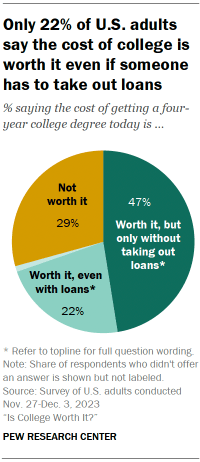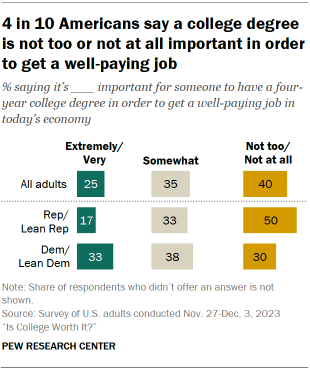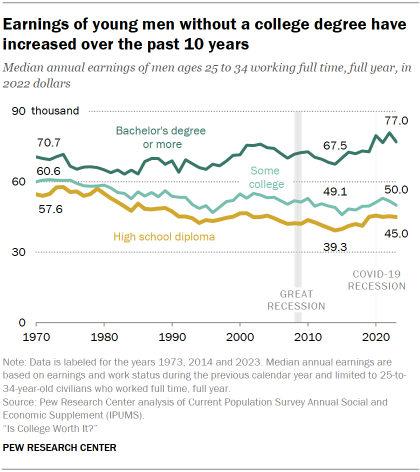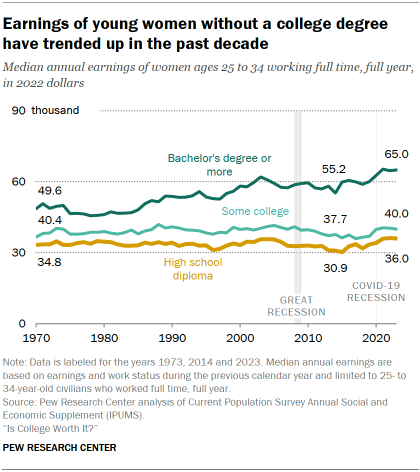As economic outcomes for young adults with and without degrees have improved, Americans hold mixed views on the value of college

Pew Research Center conducted this study to better understand public views on the importance of a four-year college degree. The study also explores key trends in the economic outcomes of young adults among those who have and have not completed a four-year college degree.
The analysis in this report is based on three data sources. The labor force, earnings, hours, household income and poverty characteristics come from the U.S. Census Bureau’s Annual Social and Economic Supplement of the Current Population Survey. The findings on net worth are based on the Federal Reserve’s Survey of Consumer Finances.
The data on public views on the value of a college degree was collected as part of a Center survey of 5,203 U.S. adults conducted Nov. 27 to Dec. 3, 2023. Everyone who took part in the survey is a member of Pew Research Center’s American Trends Panel (ATP), an online survey panel that is recruited through national, random sampling of residential addresses. Address-based sampling ensures that nearly all U.S. adults have a chance of selection. The survey is weighted to be representative of the U.S. adult population by gender, race, ethnicity, partisan affiliation, education and other categories. Read more about the ATP’s methodology.
Here are the questions used for this report, along with responses, and the survey’s methodology.
Young adults refers to Americans ages 25 to 34.
Noncollege adults include those who have some college education as well as those who graduated from high school but did not attend college. Adults who have not completed high school are not included in the analysis of noncollege adults. About 6% of young adults have not completed high school. Trends in some labor market outcomes for those who have not finished high school are impacted by changes in the foreign-born share of the U.S. population. The Census data used in this analysis did not collect information on nativity before 1994.
Some college includes those with an associate degree and those who attended college but did not obtain a degree.
The some college or less population refers to adults who have some college education, those with a high school diploma only and those who did not graduate high school.
A full-time, full-year worker works at least 50 weeks per year and usually 35 hours a week or more.
The labor force includes all who are employed and those who are unemployed but looking for work.
The labor force participation rate is the share of a population that is in the labor force.
Young adults living independently refers to those who are not living in the home of either of their parents.
Household income is the sum of incomes received by all members of the household ages 15 and older. Income is the sum of earnings from work, capital income such as interest and dividends, rental income, retirement income, and transfer income (such as government assistance) before payments for such things as personal income taxes, Social Security and Medicare taxes, union dues, etc. Non-cash transfers such as food stamps, health benefits, subsidized housing and energy assistance are not included. As household income is pretax, it does not include stimulus payments or tax credits for earned income and children/dependent care.
Net worth, or wealth, is the difference between the value of what a household owns (assets) and what it owes (debts).
All references to party affiliation include those who lean toward that party. Republicans include those who identify as Republicans and those who say they lean toward the Republican Party. Democrats include those who identify as Democrats and those who say they lean toward the Democratic Party.
At a time when many Americans are questioning the value of a four-year college degree, economic outcomes for young adults without a degree are improving.

After decades of falling wages, young U.S. workers (ages 25 to 34) without a bachelor’s degree have seen their earnings increase over the past 10 years. Their overall wealth has gone up too, and fewer are living in poverty today.
Things have also improved for young college graduates over this period. As a result, the gap in earnings between young adults with and without a college degree has not narrowed.
The public has mixed views on the importance of having a college degree, and many have doubts about whether the cost is worth it, according to a new Pew Research Center survey.
- Only one-in-four U.S. adults say it’s extremely or very important to have a four-year college degree in order to get a well-paying job in today’s economy. About a third (35%) say a college degree is somewhat important, while 40% say it’s not too or not at all important.
- Roughly half (49%) say it’s less important to have a four-year college degree today in order to get a well-paying job than it was 20 years ago; 32% say it’s more important, and 17% say it’s about as important as it was 20 years ago.
- Only 22% say the cost of getting a four-year college degree today is worth it even if someone has to take out loans. Some 47% say the cost is worth it only if someone doesn’t have to take out loans. And 29% say the cost is not worth it.
These findings come amid rising tuition costs and mounting student debt. Views on the cost of college differ by Americans’ level of education. But even among four-year college graduates, only about a third (32%) say college is worth the cost even if someone has to take out loans – though they are more likely than those without a degree to say this.
Four-year college graduates (58%) are much more likely than those without a college degree (26%) to say their education was extremely or very useful in giving them the skills and knowledge they needed to get a well-paying job. (This finding excludes the 9% of respondents who said this question did not apply to them.)

Views on the importance of college differ widely by partisanship. Republicans and Republican-leaning independents are more likely than Democrats and Democratic leaners to say:
- It’s not too or not at all important to have a four-year college degree in order to get a well-paying job (50% of Republicans vs. 30% of Democrats)
- A college degree is less important now than it was 20 years ago (57% vs. 43%)
- It’s extremely or very likely someone without a four-year college degree can get a well-paying job (42% vs. 26%)
Labor force trends and economic outcomes for young adults
At the same time that the public is expressing doubts about the value of college, a new Center analysis of government data finds young adults without a college degree are doing better on some key measures than they have in recent years.
A narrow majority of workers ages 25 to 34 do not have a four-year college degree (54% in 2023). Earnings for these young workers mostly trended downward from the mid-1970s until roughly a decade ago.
Outcomes have been especially poor for young men without a college degree. Other research has shown that this group saw falling labor force participation and sagging earnings starting in the early 1970s, but the last decade has marked a turning point.
This analysis looks at young men and young women separately because of their different experiences in the labor force.
Trends for young men
- Labor force participation: The share of young men without a college degree who were working or looking for work dropped steadily from 1970 until about 2014. Our new analysis suggests things have stabilized somewhat for this group over the past decade. Meanwhile, labor force participation among young men with a four-year degree has remained mostly flat.
- Full-time, full-year employment: The share of employed young men without a college degree who are working full time and year-round has varied somewhat over the years – trending downward during recessions. It’s risen significantly since the Great Recession of 2007-09, with the exception of a sharp dip in 2021 due to the COVID-19 pandemic. For employed young men with a college degree, the share working full time, full year has remained more stable over the years.

- Median annual earnings: Since 2014, earnings have risen for young men with some college education and for those whose highest attainment is a high school diploma. Even so, earnings for these groups remain below where they were in the early 1970s. Earnings for young men with a bachelor’s degree have also trended up, for the most part, over the past 10 years.
- Poverty: Among young men without a college degree who are living independently from their parents, the share in poverty has fallen significantly over the last decade. For example, 12% of young men with a high school diploma were living in poverty in 2023, down from a peak of 17% in 2011. The share of young men with a four-year college degree who are in poverty has also fallen and remains below that of noncollege young men.
Trends for young women
- Labor force participation: The shares of young women with and without a college degree in the labor force grew steadily from 1970 to about 1990. Among those without a college degree, the share fell after 2000, and the drop-off was especially sharp for young women with a high school diploma. Since 2014, labor force participation for both groups of young women has increased.
- Full-time, full-year employment: The shares of employed young women working full time and year-round, regardless of their educational attainment, have steadily increased over the decades. There was a decline during and after the Great Recession and again (briefly) in 2021 due to the pandemic. Today, the shares of women working full time, full year are the highest they’ve ever been across education levels.

- Median annual earnings: Median earnings for young women without a college degree were relatively flat from 1970 until about a decade ago. These women did not experience the steady decline in earnings that noncollege young men did over this period. By contrast, earnings have grown over the decades for young women with a college degree. In the past 10 years, earnings for women both with and without a college degree have risen.
- Poverty: As is the case for young men without a college degree, the share of noncollege young women living in poverty has fallen substantially over the past decade. In 2014, 31% of women with a high school diploma who lived independently from their parents were in poverty. By 2023, that share had fallen to 21%. Young women with a college degree remain much less likely to be in poverty than their counterparts with less education.




